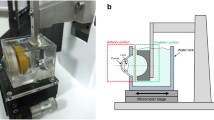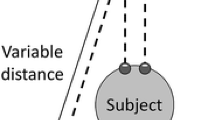Abstract
Purpose
Our purpose was to determine the changes in anterior chamber depth (ACD) and central lens thickness (CLT) during pharmacologically induced accommodation.
Methods
Following pupillary dilation with phenylephrine 10%, baseline auto-refractions and swept-source optical coherence tomographic biometric images (Zeiss IOLMaster 700) were obtained from the right eyes of 25 subjects aged 19 to 24 years. Pilocarpine 4% and phenylephrine 10% were then instilled into these right eyes. One hour later, auto-refractions and biometric imaging were repeated. Only data from eight of 25 subjects met the following stringent criteria to be included in the study analysis: pre and post-pilocarpine biometric foveal images were registerable, the images of the corneal centers were shifted by ≤100 μm, pupils >5 mm and the pharmacologically induced refractive change was ≥ −7 diopters.
Results
The mean auto-refractive accommodative change for the eight included subjects was −12.45 diopters (± 3.45 diopters). The mean change in CLT was 81 μm (± 54 μm) and the mean change in ACD was −145 μm (± 86 μm). Superimposition of the registered pre and post-pilocarpine biometric images of the sagittal sections of the whole eye from each subject demonstrated that the position of the whole lens did not shift either anteriorly, posteriorly or vertically during pharmacologically induced accommodation.
Conclusions
A small increase in lens thickness was associated with a large change in accommodative amplitude and no significant change in lens position as predicted by the Schachar theory.


Similar content being viewed by others
References
Enright JT (1980) Ocular translation and cyclotorsion due to changes in fixation distance. Vis Res 20:595–601
Buehren T, Collins MJ, Loughridge J, Carney LG, Iskander DR (2003) Corneal topography and accommodation. Cornea 22:311–316
Steffen H, Walker MF, Zee DS (2000) Rotation of Listing’s plane with convergence: independence of eye position. Invest Ophthal Vis Sci 41:715–721
Cha DI, Lee MW, Song KD et al (2017) A prospective comparison between auto-registration and manual registration of real-time ultrasound with MR images for percutaneous ablation or biopsy of hepatic lesions. Abdom Radiol 42:1799–1808
Che C, Mathai TS, Galeotti J (2017) Ultrasound registration: a review. Methods 15:128–143
Cleary K, Peters TM (2010) Image-guided interventions: technology review and clinical applications. Annu Rev Biomed Eng 12:119–142
Gu Y, McNamara JA Jr (2008) Cephalometric superimpositions. A comparison of anatomical and metallic implant methods. Angle Orthod 78:967–976
Hill DL, Batchelor PG, Holden M, Hawkes DJ (2001) Medical image registration. Phys Med Biol 46:R1–R45
Kim JS, Ishikawa H, Sung KR et al (2009) Retinal nerve fibre layer thickness measurement reproducibility improved with spectral domain optical coherence tomography. Br J Ophthalmol 93:1057–1063
Chin EK, Sedeek RW, Li Y, Beckett L, Redenbo E, Chandra K, Park SS (2012) Reproducibility of macular thickness measurement among five OCT instruments: effects of image resolution, image registration, and eye tracking. Ophthalmic Surg Lasers Imaging 43:97–108
Mendez N, Kommana SS, Szirth B, Khouri AS (2015) Structural changes by spectral domain optical coherence tomography in patients with type 1 diabetes mellitus. J Diabetes Sci Technol 10:271–276
Sohrab MA, Smith RT, Salehi-Had H, Sadda SR, Fawzi AA (2011) Image registration and multimodal imaging of reticular pseudodrusen. Invest Ophthalmol Vis Sci 52:5743–5748
Ramsey DJ, Sunness JS, Malviya P, Applegate C, Hager GD, Handa JT (2014) Automated image alignment and segmentation to follow progression of geographic atrophy in age-related macular degeneration. Retina 34:1296–1307
Schachar R A, Tello C, Cudmore DP, Liebmann JM, Black TD, Ritch R (1996) In vivo increase of the human lens equatorial diameter during accommodation. Am J Physiol 271(3 pt. 2):R670-676
IOL Master 700 (2015) User Manual. Carl Zeiss Meditec, AG, Jena, Germany, pp 40–50
Kunert KS, Peter M, Blum M, Haigis W, Sekundo W, Schütze J, Büehren T (2016) Repeatability and agreement in optical biometry of a new swept-source optical coherence tomography-based biometer versus partial coherence interferometry and optical low-coherence reflectometry. J Cataract Refract Surg 42:76–83
Garza-Leon M, Fuentes-de la Fuente HA, García-Treviño AV (2016) Repeatability of ocular biometry with IOLMaster 700 in subjects with clear lens. Int Ophthalmol. https://doi.org/10.1007/s10792-016-0380-7
Hoffer KJ, Hoffmann PC, Savini G (2016) Comparison of a new optical biometer using swept-source optical coherence tomography and a biometer using optical low-coherence reflectometry. J Cataract Refract Surg 42:1165–1172
Sisó-Fuertes I, Domínguez-Vicent A, del Águila-Carrasco A, Ferrer-Blasco T, Montés-Micó R (2015) Corneal changes with accommodation using dual Scheimpflug photography. J Cataract Refract Surg 41:981–989
Schachar RA (2012) The mechanism of accommodation and presbyopia. Kugler Publications, Amsterdam
von Helmholtz H (1855) Uber die akkommodation des auges. Archiv für Ophthalmol 1:1–74
Esteve-Taboada JJ, Del Águila-Carrasco AJ, Bernal-Molina P, Ferrer-Blasco T, López-Gil N, Montés-Micó R (2016) Effect of phenylephrine on the accommodative system. J Ophthalmol. https://doi.org/10.1155/2016/7968918
Koretz JF, Kaufman PL, Neider MW, Goeckner PA (1989) Accommodation and presbyopia in the human eye - aging of the anterior segment. Vis Res 29:1685–1692
Chien CH, Huang T, Schachar RA (2006) Analysis of human crystalline lens accommodation. J Biomech 39:672–680
Schachar RA, Bax AJ (2001) Mechanism of human accommodation as analyzed by nonlinear finite element analysis. Compr Ther 27(Summer):122–132
Schachar RA (2011) Finite element analysis and the Schachar mechanism of accommodation. J Cataract Refract Surg 37:979
Van de Sompel D, Kunkel GJ, Hersh PS, Smits AJ (2010) Model of accommodation: contributions of lens geometry and mechanical properties to the development of presbyopia. Cataract Refract Surg 36:1960–1971
Besner S, Scarcelli G, Pineda R, Yun SH (2016) In vivo Brillouin analysis of the aging crystalline lens. Invest Ophthalmol Vis Sci 57:5093–5100
Wold JE, Hu A, Chen S, OD, Glasser A (2003) Subjective and objective measurement of human accommodative amplitude. J Cataract Refract Surg 29:1878-1888
Kirkwood BR, Sterne AC (2003) Medical statistics, 2nd edn. Blackwell Science, Malden, Massachusetts, pp 413–428
Schachar RA, Mani M, Schachar IH (2017) Image registration reveals central lens thickness minimally increases during accommodation. Clin Ophthalmol 11:1625–1636
Bland JM, Altman DG (1986) Statistical methods for assessing agreement between two methods of clinical measurement. Lancet 1(8476):307–310
Eisenhauer JG (2003) Regression through the origin. Teach Stat 25:76–80
Neri A, Ruggeri M, Protti A, Leaci R, Gandolfi SA, Macaluso C (2015) Dynamic imaging of accommodation by swept-source anterior segment optical coherence tomography. J Cataract Refract Surg 41:501–510
Martinez-Enriquez E, Pérez-Merino P, Velasco-Ocana M, Marcos S (2017) OCT-based full crystalline lens shape change during accommodation in vivo. Biomed Opt Express 8:918–933
Richdale K, Bullimore MA, Zadnik K (2008) Lens thickness with age and accommodation by optical coherence tomography. Ophthalmic Physiol Opt 28:441–447
Ramasubramanian V, Glasser A (2015) Prediction of accommodative optical response in prepresbyopic patients using ultrasound biomicroscopy. J Cataract Refract Surg 41:964–980
Ni Y, Liu XL, Wu MX, Lin Y, Sun YY, He C, Liu YZ (2011) Objective evaluation of the changes in the crystalline lens during accommodation in young and presbyopic populations using Pentacam HR system. Int J Ophthalmol 4:611–615
Jones CE, Atchison DA, Pope JM (2007) Changes in lens dimensions and refractive index with age and accommodation. Optom Vis Sci 84:990–995
Tsorbatzoglou A, Németh G, Széll N, Biró Z, Berta A (2007) Anterior segment changes with age and during accommodation measured with partial coherence interferometry. J Cataract Refract Surg 33:1597–1601
Dubbelman M, van der Heijde GL, Weeber HA (2005) Change in shape of the aging human crystalline lens with accommodation. Vision Res 45:117–132
Smith G, Atchison DA (1997) The eye and visual optical instruments. Cambridge University Press Cambridge, UK, pp 778–790
Chang YC, Liu K, de Freitas C, Pham A et al (2017) Assessment of eye length changes in accommodation using dynamic extended depth OCT. Biomed Opt Express 8:2709–2719
Duke-Elder SS (1969) Diseases of the lens and vitreous; glaucoma and hypotony. In: Duke-elder SS (ed) system of ophthalmology, vol XI. London, pp 125-142
Goss DA, Van Veen HG, Rainey BB, Feng B (2002) Ocular components measured by keratometry, phakometry, and ultrasonography in emmetropic and myopic optometry students. Optom Vis Sci 80:226–236
Duane A (1912) Normal values of the accommodation at all ages. JAMA 59:1010–1013
Vanderploeg JM (1985) Near visual acuity measurements of space shuttle crewmembers. Aviat Space Environ Med 57:492
Schachar RA, Cudmore DP (1994) The effect of gravity on the amplitude of accommodation. Ann Ophthalmol 26:65–70
Schachar RA (2016) Gravity does not affect lens position during accommodation. Invest Ophthalmol Vis Sci 57:4566–4567
Augousti AT, Pierscionek BK (2016) Gravity does not affect accommodative amplitude. Invest Ophthalmol Vis Sci 57:4570
Schachar RA, Chan RW, Fu M (2011) Viscoelastic properties of fresh human lenses under 40 years of age: implications for the aetiology of presbyopia. Br J Ophthalmol 95:1010–1013
Tscherning M (1904) Physiological optics, 2nd edn. The Keyston, Philadelphia, Pennsylvania, pp 160–189
Fincham EF (1937) Mechanism of accommodation. Br J Ophthalmol 8(supplement):2–80
Schachar RA, Koivula A (2008) The stress on the anterior lens surface during human in vivo accommodation. Br J Ophthalmol 92:348–350
Kirschkamp T, Dunne M, Barry JC (2004) Phakometric measurement of ocular surface radii of curvature, axial separations and alignment in relaxed and accommodated human eyes. Ophthalmic Physiol Optics 24:65–73
Sokolowska A, Thorn F (2003) Accommodation induced changes in crystalline lens position. Invest Ophthalmol Vis Sci 44(E-Abstract #):4072
Schachar RA, Davila C, Pierscionek BK, Chen W, Ward WW (2007) The effect of human in vivo accommodation on crystalline lens stability 91:790-793
Young T (1801) On the mechanism of the eye. Philos Trans R Soc 92:23–88
Ivanoff A (1956) About the spherical aberration of the eye. J Opt Soc Am 46:901–903
He JC, Burns SA, Marcos S (2000) Monochromatic aberrations in the accommodated human eye. Vis Res 40:41–48
Ninomiya S, Fujikado T, Kuroda T, Maeda N, Tano Y, Oshika T, Hirohara Y, Mihashi T (2002) Changes of ocular aberration with accommodation. Am J Ophthalmol 134:924–926
Hazel CA, Cox MJ, Strang NC (2003) Wavefront aberration and its relationship to the accommodative stimulus-response function in myopic subjects. Optom Vis Sci 80:151–158
Plainis S, Ginis HS, Pallikaris A (2005) The effect of ocular aberrations on steady state errors of accommodative response. J Vis 5:466–477
Li YJ, Choi JA, Kim H, Yu SY, Joo CK (2011) Changes in ocular wavefront aberrations and retinal image quality with objective accommodation. J Cataract Refract Surg 37:835–841
Zhou X-Y, Wang L, Zhou X-T, Yu Z-Q (2015) Wavefront aberration changes caused by a gradient of increasing accommodation stimuli. Eye 29:115–121
Ke B, Mao X, Jiang H, He J, Liu C, Li M, Yuan Y, Wang J (2017) The relationship between high-order aberration and anterior ocular biometry during accommodation in young healthy adults. Invest Ophthal Vis Sci 58:5628–5635
Funding
No funding was received for this research.
Author information
Authors and Affiliations
Corresponding author
Ethics declarations
Conflict of interest
All authors certify that they have no affiliations with or involvement in any organization or entity with any financial interest (such as honoraria; educational grants; participation in speakers’ bureaus; membership, employment, consultancies, stock ownership, or other equity interest; and expert testimony or patent-licensing arrangements), or non-financial interest (such as personal or professional relationships, affiliations, knowledge or beliefs) in the subject matter or materials discussed in this manuscript.
Ethical approval
All procedures performed in studies involving human participants were in accordance with the ethical standards of the institutional and/or national research committee and with the 1964 Declaration of Helsinki and its later amendments or comparable ethical standards.
Informed consent
Informed consent was obtained from all individual participants included in the study.
Rights and permissions
About this article
Cite this article
Grzybowski, A., Schachar, R.A., Gaca-Wysocka, M. et al. Mechanism of accommodation assessed by change in precisely registered ocular images associated with concurrent change in auto-refraction. Graefes Arch Clin Exp Ophthalmol 256, 395–402 (2018). https://doi.org/10.1007/s00417-017-3843-2
Received:
Revised:
Accepted:
Published:
Issue Date:
DOI: https://doi.org/10.1007/s00417-017-3843-2




